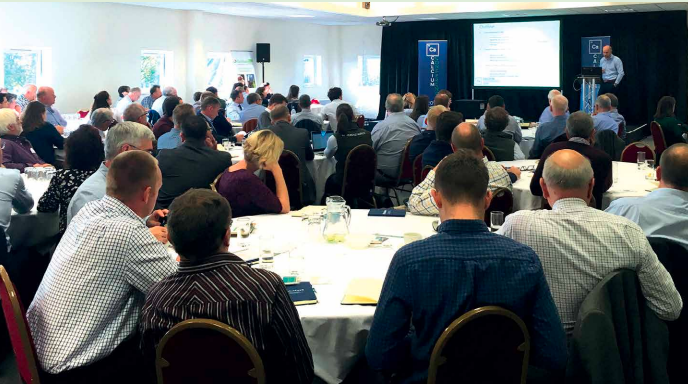
10th October 2018 – At Nantwich Football Club
Calcium has a key role in maintaining healthy, fertile soils and the production of high-quality crops and forages. Yet it is estimated that 60% of UK soils are below optimal levels of pH and calcium, and the importance of this key nutrient is often overlooked. To help put calcium under the spotlight, granulated lime manufacturer, Calcifert, hosted the UK’s first Calcium Conference back in October. The event attracted an audience of more than 100 agronomists, arable producers, soil specialists and livestock farmers; highlighting the wide range of applications that calcium has within the agricultural sector. Whilst the day’s seven speakers tackled a diverse range of subjects – from the practicalities of measuring calcium levels in soil, to interpreting calcium test results – what was clear from all of the presentations is just how important-a-role calcium has on plant growth and soil biology, and that this should be of significant interest to arable farmers.
Ian Robertson urges detailed approach to soil testing
Agronomist and managing director of Sustainable Soil Management, Ian Robertson, highlighted the need for detailed soil testing before decisions on nutrient inputs are made. Ian’s presentation looked closely at both the importance of calcium to plant health and cell wall development, but also calcium uptake and how much of this vital element needs to be supplied to a plant. Ian advocates carrying out more than a simple pH,P,K and Mg soil test, as focusing on these elements alone may not be enough to improve soil conditions. The four major cations (Ca,Mg,K,Na) should always be included as part of a test.

Calcium is a major component of any soil test, but a simple PPM result is not enough to inform a nutrient program. A soils Cation Exchange Capacity (CEC) should also be determined to help balance the cations in a soil in order to achieve the optimum soil pH and soil structure. An understanding of both available and total calcium in the soil, which can be matched to crop demand, will improve production and health. As well as reminding the audience that pH is not the measure of calcium and consideration of other cations was vital, Ian also emphasised the importance of CEC and its relation to soil calcium results. Ian’s overarching message when it comes to calcium recommendations is a straightforward one – a simple calcium analysis will not provide you with all the information needed to make an informed decision when formulating a soil nutrient program.
Calcium in a zerotill system
As part of the afternoon session, Clive Bailye, managing partner at TWB Farms, shared the importance of calcium within his zerotill farming system. Clive has used a zerotill system for 10 harvests, judging it to bring both financial and environmental sustainability to his business. According to Clive the only way to achieve healthy crops is through healthy soil, and the factors he believes make the difference between success and failure are soil nutrition, rotation and attitude – not soil type or machinery. Recognising calcium’s key role to soil nutrition, Clive pays attention to understanding what calcium requirement his soil needs and uses pH zone testing to compensate for the highly variable pH in his soils.

High quality ground Derbyshire limestone is used for bulk calcium applications ahead of spring cropping. Where a maintenance dressing is required to keep pH at the required level, Clive applies 100kgs per hectare of Calcifert Lime in spring, running machinery along existing 36m tramlines. In his presentation Clive highlighted an issue with acidic phytotoxins, which had been identified in wet anaerobic conditions. To help prevent seedling damage, Calcifert Lime is also applied at drilling with the help of a modification to the drill.
Clive’s key message for all growers was to use calcium to flocculate the soil; restoring its natural aerobic environment and enabling the soil biology to thrive with the aid of the available calcium. Summarising the messages from speakers at the conference, agronomist and conference chair, Mark Tripney, encouraged farmers to challenge the norm when it comes to soil testing, and in particular calcium testing. He concluded that only by carrying out detailed analysis can you really strive to achieve a better balance of nutrients and ensure you get the most from your soil.

